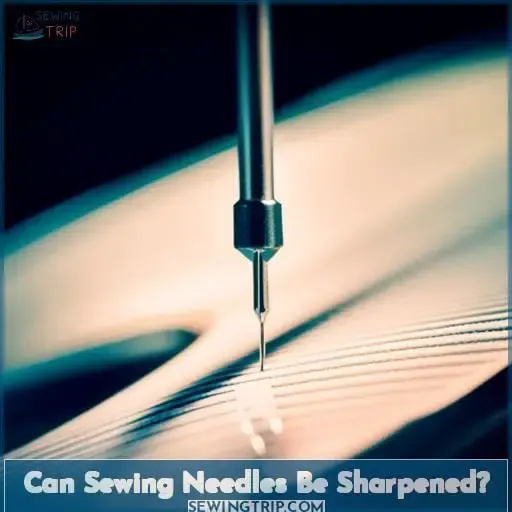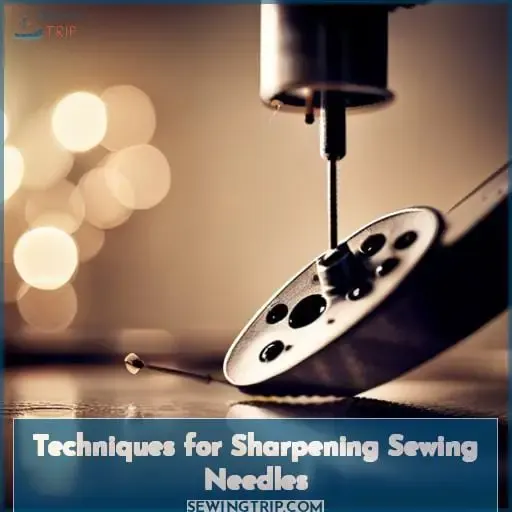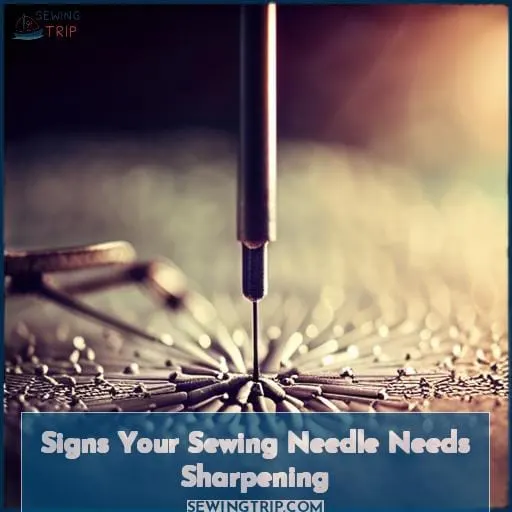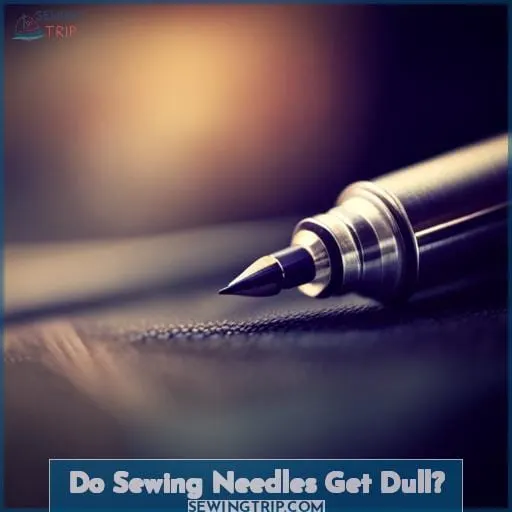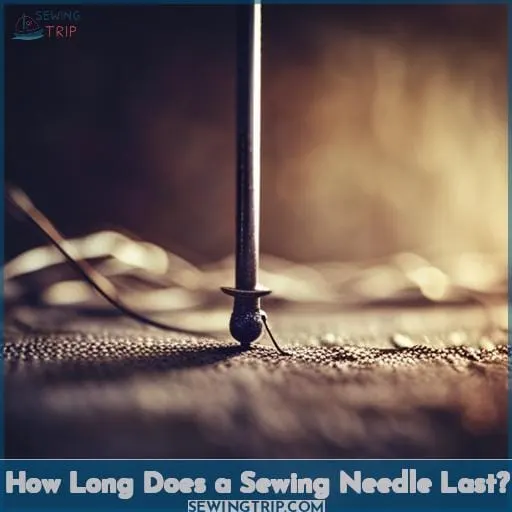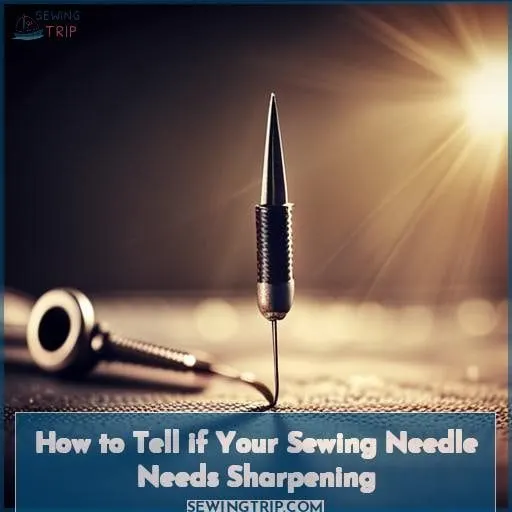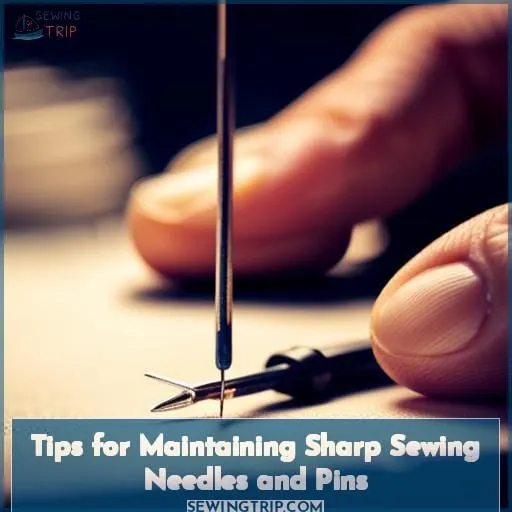This site is supported by our readers. We may earn a commission, at no cost to you, if you purchase through links.
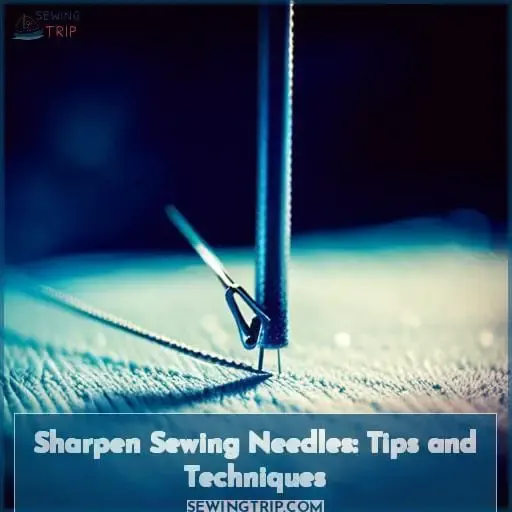 Imagine having the power to effortlessly glide your sewing needle through fabric, creating perfect stitches every time. With our tips and techniques, you can sharpen your sewing needles like a pro. Say goodbye to frustrating thread breaks and uneven stitches.
Imagine having the power to effortlessly glide your sewing needle through fabric, creating perfect stitches every time. With our tips and techniques, you can sharpen your sewing needles like a pro. Say goodbye to frustrating thread breaks and uneven stitches.
Whether you prefer using a candle, soap bar, emery board, steel wool pincushion or coconut oil – we’ve got you covered! Discover how to maintain sharp needles for ultimate sewing mastery in this article on sharpening sewing needles: Tips and Techniques.
Table Of Contents
- Key Takeaways
- Can Sewing Needles Be Sharpened?
- Techniques for Sharpening Sewing Needles
- Signs Your Sewing Needle Needs Sharpening
- Do Sewing Needles Get Dull?
- How Long Does a Sewing Needle Last?
- Can You Sharpen Sewing Machine Needles?
- How to Tell if Your Sewing Needle Needs Sharpening
- Tips for Maintaining Sharp Sewing Needles and Pins
- Frequently Asked Questions (FAQs)
- Conclusion
Key Takeaways
- Sharpening sewing needles is important for extending their lifespan and improving stitch quality.
- There are various techniques for sharpening sewing needles, such as using a candle flame or rubbing against a soap bar.
- Signs that a sewing needle needs sharpening include constant thread breakage, uneven stitches, and dull or bent needle tips.
- Proper maintenance and cleaning, as well as regularly checking for signs of dullness, can help prolong the lifespan of sewing needles.
Can Sewing Needles Be Sharpened?
Yes, you can sharpen sewing needles to extend their lifespan. Sharpening techniques vary, but the goal is to restore the needle’s sharpness and ensure smooth stitching. Proper needle maintenance is essential for optimal sewing performance. Sewing machine needles can also be sharpened using similar methods as hand-sewing needles.
There are several reasons why it’s important to sharpen your sewing needles regularly: it improves stitch quality, prevents fabric snags or tears, and reduces thread breakage during sewing projects. Signs of a dull needle include uneven stitches, broken threads, and unwanted holes in the fabric.
By staying vigilant and maintaining sharp pins and needles through regular sharpening practices, you’ll enhance your mastery of the craft while saving money on frequent replacements.
Techniques for Sharpening Sewing Needles
Now let’s explore some techniques for sharpening your sewing needles.
There are a few different methods you can try, including:
- Using a candle flame to heat the tip and then running it over an emery board or sandpaper.
- Rubbing the needle against a bar of soap to smooth out any roughness.
- Creating your own pincushion filled with steel wool for sharpening purposes.
- Using coconut oil as a lubricant while gently pulling the needle through folded aluminum foil multiple times.
These techniques will help keep your needles sharp and ready for precise stitching.
Using a Candle
To sharpen your sewing needles, try using a candle.
This candle technique involves holding the needle over an open flame to heat and melt the wax, which helps to restore sharpness.
Using a Soap Bar
To sharpen your sewing needles, try using a soap bar.
Rub the needle against the soap in a downward motion to remove any burrs and restore sharpness.
Maintain your sewing tools for optimal performance.
Using an Emery Board
To sharpen your sewing needles using an emery board, simply:
- Rub the needle against the rough surface in a downward motion.
This technique helps restore needle sharpness and prolongs their lifespan.
Using Steel Wool as a Pincushion
Sharpen your sewing needles by utilizing steel wool as a pincushion. This alternative method for needle maintenance and sharpening pins is effective in prolonging the lifespan of your sewing tools.
Using Coconut Oil
When sharpening your sewing needles, try using coconut oil.
It’s an alternative method that can provide benefits such as lubrication and preventing thread breaking.
Exercise caution when applying the oil to avoid excessive greasiness.
Signs Your Sewing Needle Needs Sharpening
If you notice that your thread is constantly breaking while sewing, it may be a sign that your sewing needle needs sharpening.
Another indication is when your stitches aren’t even and consistent, which can affect the overall quality of your project.
Additionally, if you find unwanted holes in the fabric or experience difficulty with fabric puckering while stitching, these are also signs that it’s time to sharpen your needle.
Your Thread is Breaking
If you notice that your thread is breaking while sewing, it may be a sign that your sewing needle needs sharpening.
Sharpening your needle can prevent thread breakage and ensure smooth stitching.
Your Stitches Are Not Even
If your stitches aren’t even, it may be a sign that your sewing needle needs sharpening. Uneven stitches can result from a dull needle, affecting the overall quality of your sewing project.
Unwanted Holes in the Fabric
If you notice unwanted holes in your fabric while sewing, it’s a clear sign that your sewing needle needs sharpening.
Sharpening your needle will prevent fabric puckering and other issues like thread breakage or uneven stitches.
The Fabric Puck
When you notice a fabric puck forming as you sew, it’s a clear indication that your sewing needle needs sharpening.
Repair puckered fabric by:
- Caring for your sewing needle
- Checking thread tension
- Troubleshooting your sewing machine to prevent further fabric distortion.
Do Sewing Needles Get Dull?
Sewing needles can become dull over time with repeated use and friction against fabric.
However, it’s important to note that not all sewing needles are created equal in terms of durability. Some higher-quality needles may last longer before becoming dull compared to cheaper ones.
To maintain sharpness, there are needle sharpening methods you can try, such as using an emery board or steel wool pincushion.
Regular maintenance and proper storage also play a role in prolonging sewing needle longevity.
By taking care of your needles and being mindful of their condition, you’ll ensure optimal performance during your sewing projects for years to come.
How Long Does a Sewing Needle Last?
Sewing needles typically last for a varying amount of time, depending on factors such as frequency of use and the type of fabric being sewn. It’s important to understand how long your sewing needle will last so that you can plan for regular maintenance and replacement.
Here are some key points about the lifespan of sewing needles:
- Proper needle maintenance, including sharpening techniques and regular cleaning, can extend their lifespan.
- Needles used on heavy fabrics or with frequent use may need to be replaced more often.
- Signs that your needle needs replacing include thread breaking, uneven stitches, unwanted holes in the fabric, and puckering.
- Sewing machine needles also have a limited lifespan due to wear and tear from repetitive motion.
By understanding how long a sewing needle lasts and recognizing signs of dullness or damage, you can ensure optimal performance while working on your projects. Regularly maintaining your needles will help you achieve cleaner stitches with less frustration along the way.
Can You Sharpen Sewing Machine Needles?
If you own a sewing machine, you may be wondering if it’s possible to sharpen your sewing machine needles. The good news is that yes, sewing machine needles can be sharpened using various techniques. Sharpening your needles can extend their lifespan and improve the quality of your stitches.
Here are some techniques you can try:
| Technique | Description |
|---|---|
| Using a Needle Sharpener | Needle sharpeners are specifically designed for sharpening sewing machine needles. Simply insert the needle into the sharpener and rotate it to remove any burrs or dullness from the tip. |
| Using an Emery Board | Gently rub the needle against an emery board in a downward motion to smooth out any rough edges or blunt points. |
| Using Steel Wool as Pincushion Filling | Place a small piece of steel wool in the bottom of your pincushion. As you push the needle into the pincushion, the steel wool will help to sharpen the needle. |
How to Tell if Your Sewing Needle Needs Sharpening
Now that you know how to sharpen sewing machine needles, let’s focus on how to tell if your sewing needle needs sharpening.
Checking the sharpness of your needle is an essential part of needle maintenance and ensuring optimal sewing quality. By recognizing the signs early on, you can prolong the lifespan of your needles and prevent fabric damage.
Here are three ways to determine if it’s time for a sharpening session:
- Your stitches aren’t even: If you notice irregular or skipped stitches in your projects, it could be a sign that your needle is dull.
- Unwanted holes in the fabric: Dull needles tend to create larger holes than necessary when piercing through fabrics.
- The fabric puckers while stitching: A dull needle may cause the fabric to gather or pucker as it struggles with smooth penetration.
By regularly checking for these indicators, you can ensure sharp needles and maintain high-quality results throughout all of your sewing projects.
Tips for Maintaining Sharp Sewing Needles and Pins
To maintain sharp sewing needles and pins, it’s important to implement proper care and storage practices.
-
Needle maintenance:
- Change needles regularly.
- Use the right needle for the fabric.
- Inspect them for damage.
-
Pin types:
- Familiarize yourself with different pin types such as safety pins, straight pins, and multi-purpose pins like Magic Pins.
-
Pinmoor benefits:
- Consider using Pinmoors as an alternative to safety pins. They prevent pokes and injuries while providing efficient quilt basting.
By following these tips, you can ensure that your sewing needles remain sharp for efficient stitching. Proper needle maintenance combined with knowledge of different pin types can enhance your overall sewing experience while achieving mastery in this craft.
Frequently Asked Questions (FAQs)
Are there any risks or potential drawbacks to sharpening sewing needles?
When it comes to sharpening sewing needles, there are a few risks you should be aware of.
Sharpening can potentially shorten the lifespan of the needle and may not restore it to its original condition.
Are there any historical practices or methods for needle sharpening?
Historically, needle sharpening was common when new needles were scarce. Singer even offered a sharpening service during wartime! However, with the availability of cheap and plentiful new needles today, it’s less necessary.
What are some alternative methods or tools for maintaining sharp sewing needles?
To maintain sharp sewing needles, try:
- Sharpening them with crushed walnuts
- Using an emery-filled pincushion
- Rubbing the needle on a small bar of soap.
Keep those needles sharp for efficient and frustration-free sewing!
How can I tell if my sewing needle needs sharpening?
To determine if your sewing needle needs sharpening, examine its tip closely.
Look for signs of bluntness or damage, such as a rounded point or bent needle.
A sharp needle will easily penetrate fabric without snagging or skipping stitches.
Can dull sewing needles be reused or repurposed for other sewing tasks?
When it comes to dull sewing needles, repurposing or reusing mightn’t be the best option.
To ensure efficient and frustration-free sewing, it’s recommended to replace dull needles with sharp ones for optimal results.
Conclusion
To become a master at sewing, it’s essential to sharpen your sewing needles regularly. By following the tips and techniques discussed in this article, you can say goodbye to frustrating thread breaks and uneven stitches.
Whether you choose to use a candle, soap bar, emery board, steel wool pincushion, or coconut oil, there are various methods to maintain sharp needles.
Remember to pay attention to signs that your sewing needle needs sharpening, such as thread breaks and uneven stitches.
Keep your sewing needles sharp for ultimate sewing mastery.

